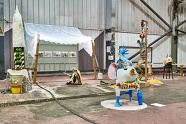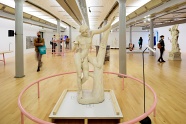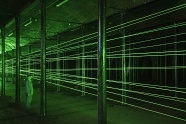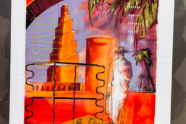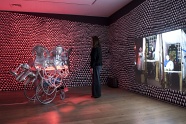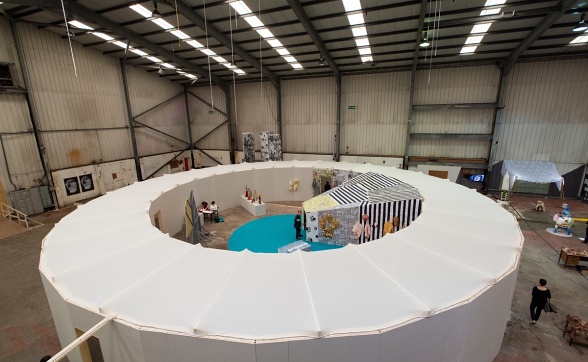
Andreas Angellidakis, Collider, 2016. Installation view at Cains Brewery. Photo: Mark McNulty

Photo: Shirlaine Forrest
Andreas Angellidakis, Collider, 2016. Installation view at Cains Brewery. Photo: Mark McNulty
Beneath the classic late Victorian former brewery on Stanhope Street is a lake that is 40 feet deep. It is rumoured that employees of the brewery used to row boats there, and in 1995 a diver found carved graffiti on the wall dating to 1864, 13 years before work began on the red brick building above.
As you walk through the brewery’s canning hall, you will encounter a number of episodes, including Chinatown, Flashback and the Children’s Episode. At the centre is the large structure Collider, designed by Andreas Angelidakis, inspired by the Large Hadron Collider – a giant instrument that operates at the boundaries of scientic knowledge. Angelidakis’s structure divides the space into different episodes.
Chinatown, the first episode you come upon, is entered through a portal made by Céline Condorelli. Chinatown contains work made on site by Ramin Haerizadeh, Rokni Haerizadeh and Hesam Rahmanian, who have sent to Liverpool objects, props, films and works from their art collection. These items have been ‘smuggled’ by sea in a shipping container from Dubai, where the Iranian artists are currently living in exile. Nearby, Audrey Cottin’s Flour Tables invite you to tell a story using the medium of dough, recorded by a graphic artist.
Sahej Rahal's sculptures made by clay and wood are part of a larger body of work that can be seen throughout the exhibition. These belong within a burgeoning mythology, which draws on characters from a range of sources, from local legend to science fiction. He encourages these indeterminate beings to emerge into our everyday lives, as if through cracks in our civilisation.
Ian Cheng’s Emissary Forks For You is a mixed reality simulation in which a small dog, Shiba Emissary, verbally commands the viewer to follow her throughout the exhibition. With promise of reward, the viewer assumes a new role: Shiba Emissary’s pet.
Lara Favaretto’s Lost and Found suitcases are the result of yearly visits to places where lost luggage can be found: flea-markets, railway stations or dumps. Having obtained a suitcase, she combines what is already inside with new items, locks the case and throws away the key. Several of these works can be found across many exhibition sites.
Rita McBride’s Perfiles depict the outline of houses in Pompeii, a city in the South of Italy that was buried in metres of ash and pumice after the volcanic eruption of Mount Vesuvius in 79AD. Sculptural memories of buildings consumed by time, the Perfiles are distributed across the exhibition.
Dispersed throughout the Biennial venues, Jason Dodge’s What the Living Do comprises small items that people left behind, such as sweet wrappers, cigarette butts, leaves, shells, receipts and used tickets. The artist has been collecting these items for many years.
As you walk inside Andreas Angelidakis’s Collider, you step into the Flashback episode. Inside is a film by Samson Kambalu that explores the ambivalent psychogeography of Liverpool’s imperial monuments, and a drawing by Koki Tanaka that he made when he was a child.
Ana Jotta’s wallpaper is created from the pages of her 2014 book Footnotes, which portrays the numerous objects and paraphernalia that she has been collecting over many years. Not overly attached to these objects, Jotta often throws them away, but not before they have helped her to generate the next work.
In a room nearby, and also part of the Flashback episode, Yin-Ju Chen’s Extrastellar Evaluations brings together evidence of Lemurian presence on earth. Lemuria is a continent that sunk beneath the ocean thousands of years ago. Its inhabitants have been living on earth in another dimension, revealing themselves as conceptual artists in the 1960s. Extrastellar Evaluations unfolds between Cains Brewery and FACT.
At the centre of the Collider is the Children’s Episode. For this episode, Céline Condorelli has designed a portal that is only for children to use. Since April 2016, Marvin Gaye Chetwynd has been working through workshops and live performances with 34 children and 44 teenagers from across Liverpool to make the film Dogsy Ma Bone, using the city as a backdrop to the action. The film is inspired by Betty Boop’s A Song A Day, 1936, in which Betty sings to exotic animals in a hospital she owns, and Bertolt Brecht’s satirical musical Threepenny Opera, 1928. Parts of the film have been remade by teenagers who have created home-made or ‘sweded’ versions of certain scenes. Over the Biennial’s opening weekend, some parts of the film are being performed live in the space by the children and teenagers themselves.
In the same space, Betty Woodman’s Kimono Ladies appear – ceramic vessels that the artist has dressed in fancy costumes. There is also an image from Koki Tanaka’s re-imagining of the 1985 Youth Training Scheme protest, in which 10,000 young people from Liverpool took to the streets in opposition to the then Conservative government’s work experience initiative. The project can be seen in full at Open Eye Gallery.Around the corner from Cains Brewery is a door, set into a brick wall. The door is a portal between Liverpool and Manchester, and it has been installed by Lu Pingyuan, who has been collecting second-hand doors over the years. The title, Do Not Open It, is a warning. Lu hopes to install similar doors all over the world, imagining that they will all remain closed forever.
The Cains Brewery site has been used for brewing beer from 1768 until its closure in 2013, having brewed over half a million barrels of beer per annum. Plans are underway to transform the site into a vibrant urban village complex, called Cains Brewery Village, hosting creative and independent-minded companies and individuals.
Cains Brewery
Stanhope Street
Liverpool
L8 5XJ
Exhibition and Visitor Hub open daily, 10am – 6pm
Liverpool Biennial
55 New Bird Street
Liverpool L1 0BW
- T +44 (0)151 709 7444
- info@biennial.com
Liverpool Biennial is funded by
Founding Supporter
James Moores
















